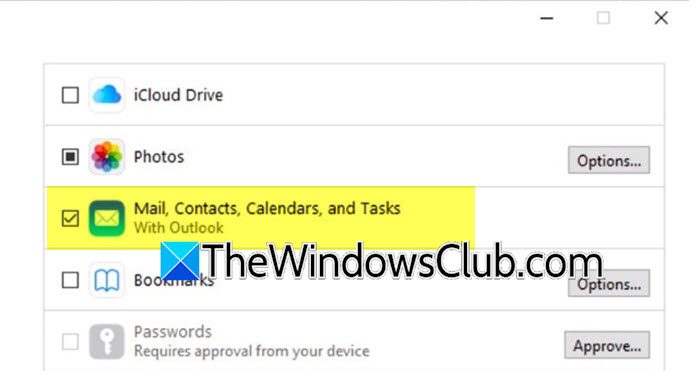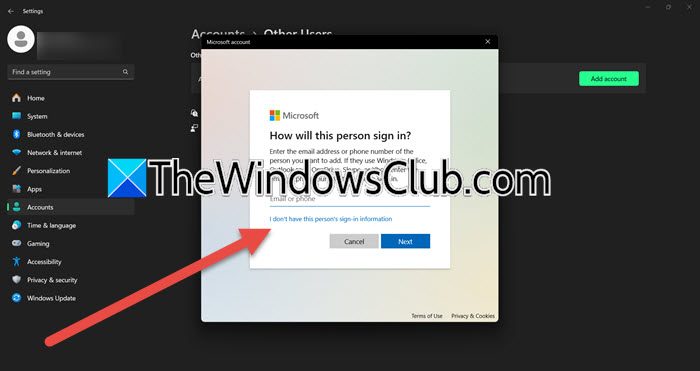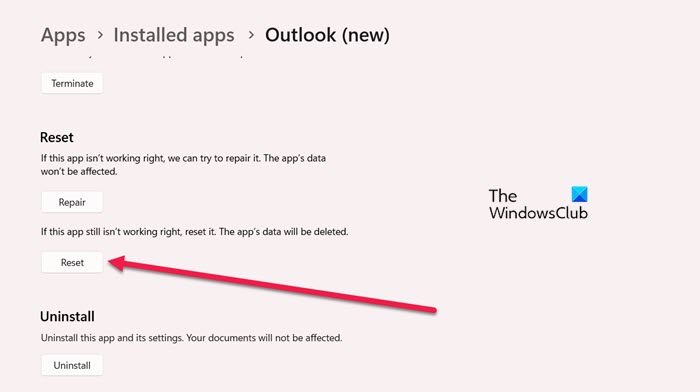If iCloud calendars and contacts are not showing up in Windows, this post will help you resolve the issue. Some users face this issue due to syncing errors, misconfigured settings, or glitches. Fortunately, several ways exist to resolve this problem and restore access to important contacts and schedules.
Why is my calendar not showing in iCloud?
The iCloud calendar may not be visible due to various issues, such as syncing issues, incorrect settings, a disabled iCloud Outlook Add-in, or a corrupted Outlook installation. In the next section, we will explore these factors in detail and provide solutions.
iCloud for Windows not showing calendars and contacts
If iCloud does not show calendars and contacts on a Windows PC, execute the solutions below.
- Turn iCloud Calendars and contacts off, and back on Close Outlook
- Make sure that the iCloud Outlook Add-in is on
- Ensure that iCloud is not the default account in Data Files
- Create a new local account
- Reset or Repair Outlook
- Contact Apple support
Let’s get started with the guide.
1] Turn iCloud Calendars and contacts off, and back on Close Outlook

The first thing we will do is turn off iCloud Calendars and Contacts and then turn them back on after a few seconds to establish a fresh sync between iCloud and the Windows system. There are times when simply disabling and enabling the feature can resolve the temporary glitches. To do the same, follow the steps mentioned below:
- Launch iCloud, sign in with your ID, and navigate to the iCloud Control Panel.
- Search for the Mail, Contacts, Calendars, and Tasks sections, and untick the box next to it to turn off syncing for these services.
- Click Apply to save the changes, wait for a few seconds, then recheck the box, and hit the Apply button to switch it on.
Verify if the contacts and calendars are now visible. If they are still not, move to the next solution.
2] Make sure that the iCloud Outlook Add-in is on
The iCloud Outlook Add-in is essential for Outlook to access iCloud data; otherwise, calendars and contacts will disappear. To ensure seamless data syncing, the necessary connection between iCloud and Outlook should remain active; therefore, it’s necessary to enable the iCloud Outlook Add-in.
- Open Outlook, click on the File menu from the top-left corner and select Options.
- Click on the Add-ins section, expand the Manage dropdown menu, and choose COM Add-ins.
- Select the GO button, search for iCloud Outlook Add-in in the list, ensure that it is ticked, and hit the OK button.
Once done, restart Outlook and check if the calendars and contacts are visible. Proceed to the next solution if it is already enabled.
3] Ensure that iCloud is not the default account in Data Files
When iCloud is set as the default account in Data Files, it can cause conflicts with Outlook’s ability to display and sync Calendars and Contacts. To avoid the issue, it is recommended to ensure that iCloud is not set as the default account in the Data Files while keeping it enabled.
- Launch Outlook, click on File, and then select Account Settings.
- Navigate to the dropdown menu again, click on Account Settings, and then go to the Data Files tab.
- Look for iCloud in the list; if there’s a checkmark next to it, it is set as the default account. Select another account and click on Set as default option. Lastly, hit the Close button to save the changes.
If you continue to experience issues, see the next solution.
4] Create a new local account

More often than not, user settings, system configurations, or registry entries interfere with iCloud’s ability to sync. A new local account can eliminate any user-specific settings or configurations that might be causing the issue, and that’s what we are going to do in this solution.
- Click Win + I to open Settings, go to Accounts, and in the Account Settings section, select Other users.
- Click on Add someone under the Other Users section, and in the Windows Microsoft window, click on ‘I don’t have this person’s sign-in information’.
- Select Add a user without a Microsoft Account, enter a username and password for the new local account, and click the Next button to create it.
- Once done, navigate to Family, select the new account, click Change account type, and set it to Administrator.
Sign in to the new account, check if calendars and contacts sync properly, and if iCloud is working fine on the new account. Transfer your data and switch to using it permanently, and if the issue continues, proceed to the next solution.
5] Reset or Repair Outlook

If calendars and contacts are still not synced even after creating a new account, then the issue might reside in Outlook itself. It may be experiencing corruption or integration issues with iCloud. In such cases, users can restore Outlook to ensure smooth synchronization with iCloud.
- Click Win + I to open Settings, go to Apps, and click on Installed Apps.
- Scroll down to find Outlook, click on the three dots menu, and select Advanced options.
- Navigate to the Reset section and click on the Repair option. If repairing doesn’t work, click on the Reset option this time to reset Outlook to its default settings, however, this procedure might delete some data.
Should the issue remain unresolved, try the next solution.
Read: iCloud will not let me sign in or sign out on PC
6] Contact Apple Support
Last but not least, if you’ve executed all of the above solutions but iCloud for Windows is still not showing calendars and contacts, it may indicate a deeper issue that requires Apple’s assistance. The problem could stem from server-side outages or software conflicts that Apple can only solve. Therefore, go to Apple’s support page, sign in with Apple ID, and type iCloud for Windows in the search bar. Follow the procedures, and hopefully, this will help resolve the issue.
Hopefully, you can resolve the issue using the solutions mentioned in this post.
How do I get my iCloud calendar on Windows?
To get iCloud Calendar on Windows, download and install iCloud for Windows from Apple’s website and sign in with an Apple ID. Next, click on the Mail, Contacts, Calendars, and Tasks options, and select OK. Once done, launch Outlook and find your iCloud calendar there. However, make sure that iCloud is enabled in Outlook’s add-in, and to know how to do it, check out the steps mentioned earlier.
Leave a Reply